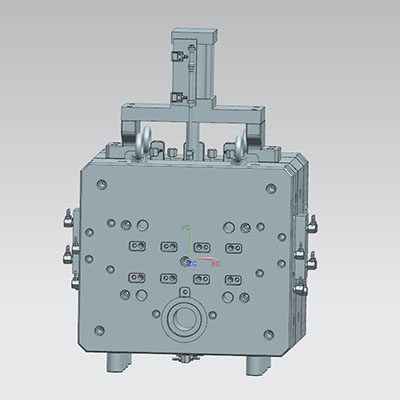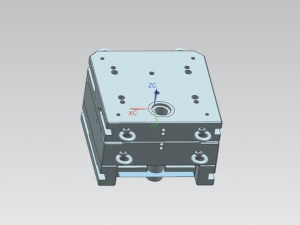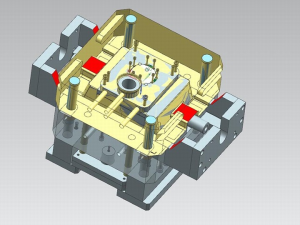Die-casting mold is one of the three major elements of die-casting production. Correct and reasonable die-casting mold making structure is the premise for the smooth production of die-casting parts, and plays an important role in ensuring the quality of castings (machine qualification rate).
Due to the characteristics of the die-casting process, the correct selection of various process parameters is the decisive factor for obtaining high-quality castings, and the die-casting mold is the premise for the correct selection and adjustment of various process parameters. The mold design is essentially a comprehensive reflection of the possible factors in die-casting production. The design of the die-casting mold is reasonable, the problems encountered in actual production are few, and the casting qualification rate is high. On the contrary, the mold design is unreasonable. For example, the dynamically fixed mold of the package is basically the same in the casting design, and the gating system is mainly in the fixed The die-casting machine can not support the injection after perforation, so the casting cannot be produced normally, and the casting has been stuck to the fixed mold. Although the finish of the mold cavity is very bright, it still sticks to the mold due to the deep cavity. In the mold design, it is necessary to comprehensively analyze the structure of the casting, be familiar with the operation process of the die-casting machine, understand the possibility of the die-casting machine and adjust the process parameters, master the packaging characteristics in different situations, and take into account the mold processing method, drilling, and Fixed molding, design a practical mold that meets production requirements.

At first, it was said that the filling time of the molten metal was very short, and the specific pressure and flow rate of the molten metal were very high, which was very unfavorable to the working conditions of the die-casting mold, coupled with the cold and thermal excitation of the alternating stress, which affected the service life of the mold. have a great impact.
The service life of the mold usually refers to the number of die-casting molds (including the amount of waste in the production of die-casting) through careful design and manufacture, under normal use conditions, combined with good repair and maintenance of natural damage, can no longer be repaired and scrapped.
In actual production, there are three main forms of mold failure: (1) thermal fatigue crack damage failure; (2) split failure; (3) corrosion failure.
There are many factors that lead to mold failure, whether it is external factors (whether the case is pouring temperature, mold preheating, how much water-based paint is sprayed, size matching, high-pressure die-casting, the tonnage gate of the die-casting machine is not opened too fast, the cooling water is synchronized with the die-casting production, High and low type and composition, casting size shape, wall thickness, size, coating type, etc.) There are also internal reasons (such as the metallurgical quality of the mold itself, the forging process of the billet, the rational design of the mold structure, the design of the gating system, etc.). Rationality, the internal stress generated by the mold machine (electric processing), the heat treatment process of the mold, including various matching accuracy and smoothness requirements, etc.).
If the mold fails early, it is necessary to find out the internal or external cause for future improvement.
(1) Mold thermal fatigue cracking failure
In die casting production, the chilling effect of the mold again and again causes the surface and internal deformation of the thermoforming, repeated cyclic thermal stress to each other, resulting in structural damage and loss of elasticity, resulting in the appearance of micro-cracks and continued to expand. Once the cracks expand, the fluid diapirs and melts metal, and repeated mechanical stress accelerates crack propagation.
Therefore, on the one hand, the mold must be fully preheated at the beginning of die casting. In addition, the mold must be kept within a certain working temperature range during the die casting process to avoid early cracking failure. Problem. Because the mold failure in actual production is mostly thermal fatigue cracking failure.
(2) Fracture failure
Under the action of the injection force, the mold will be at the weakest place, especially if the logo mark or the electric treatment mark is not polished in the forming mold, the surface or formed clear corners will first appear fine cracks, when there is a brittle stage or coarse grain boundary, also That is to say, it is easy to break. The crack propagates very fast during brittle fracture, which is a very dangerous factor for the failure of the mold. For this reason, on the one hand, any scratches on the surface of the mold, electrical machining marks must be ground, even in the gating system. In addition, the use of mold materials requires high strength, good plasticity, good impact toughness and fracture toughness.
(3) Melting failure
As mentioned above, the commonly used die casting alloys are zinc alloy, aluminum alloy, magnesium alloy, copper alloy, and pure aluminum die casting. Zn, Al and Mg are metal elements with strong activity, and they have a good affinity with die casting mold materials. , especially Al is easy to bite the mold. The higher the hardness of the mold, the better the corrosion resistance. If there are soft spots on the molding surface, the corrosion resistance will be worse. But in actual production, corrosion only occurs in the mold part, such as internal casting The direct erosion of the mouth parts (core, cavity) is prone to corrosion, while the aluminum alloy with softer hardness is prone to sticking.





